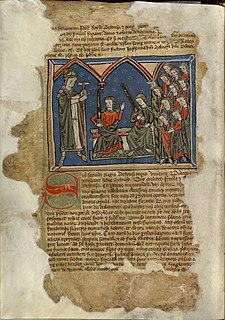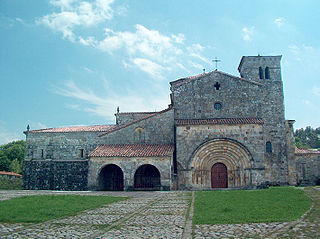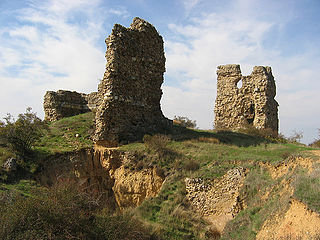Related Research Articles

Alfonso VII, called the Emperor, became the King of Galicia in 1111 and King of León and Castile in 1126. Alfonso, born Alfonso Raimúndez, first used the title Emperor of All Spain, alongside his mother Urraca, once she vested him with the direct rule of Toledo in 1116. Alfonso later held another investiture in 1135 in a grand ceremony reasserting his claims to the imperial title. He was the son of Urraca of León and Raymond of Burgundy, the first of the House of Ivrea to rule in the Iberian peninsula.

Diego Gelmírez or Xelmírez was the second bishop and first archbishop of the Catholic Archdiocese of Santiago de Compostela in Galicia, modern Spain. He is a prominent figure in the history of Galicia and an important historiographer of the Iberia of his day. Diego involved himself in many quarrels, ecclesiastical and secular, which were recounted in the Historia Compostelana, which covered his episcopacy from 1100 to 1139 and serves as a sort of gesta of the bishop's life.
FernandoPérez de Traba, also Fernão Peres de Trava in Portuguese, was a nobleman and count of the Kingdom of León who for a time held power over all Galicia. He became the lover of Countess Teresa of Portugal, through whom he attained great influence in that domain, and was the de facto ruler of the County of Portugal between 1121 and 1128. The Poema de Almería, a Latin poem celebrating one of Alfonso VII's major victories of the Reconquista, records that "if one were to see him [Fernán], one would judge him already a king."

Fernando Díaz was a Spanish nobleman and military leader in the Kingdom of León, the most powerful Asturian magnate of the period. He held the highest rank in the kingdom, that of count, from at least 24 September 1089. He was the last Count of Asturias de Oviedo and was succeeded by a castellan, a novus homo, perhaps in an ecclesiastical–royal effort to curtail the power of the Asturian aristocracy.

Gómez Núñez was a Galician and Portuguese political and military leader in the Kingdom of León. His power lay in the valley of the Minho, mainly on the north side, bounded by the Atlantic on the west and corresponding approximately with the Diocese of Tui. There, according to a contemporary source, he had "a strong site, a fence of castles and a multitude of knights and infantry."
Munio or Muño Peláez was a Galician magnate, a member of the Banu Gómez clan, during the reigns of Alfonso VI, Urraca and Alfonso VII. By December 1108 he held the title of comes (count), the highest in the kingdom. He was a son of count Pelayo Gómez, grandson son of Gómez Díaz de Carrión and Teresa Peláez. His mother was Elvira Muñoz, half-sister of count Rodrigo Muñoz, and daughter of Munio Rodríguez and Ilduara Velázquez. Elvira's ancestors had founded the monastery of Santa María de Ferreira.

Pedro Fróilaz de Traba was the most powerful secular magnate in the Kingdom of Galicia during the first quarter of the twelfth century. According to the Historia compostelana, he was "spirited ... warlike ... of great power ... a man who feared God and hated iniquity," for Diego Gelmírez himself had "fed him, like a spiritual son, with the nutriment of holy teaching." Brought up at the court of the Emperor Alfonso VI, Pedro raised the future Emperor Alfonso VII in his household. Around the latter he and Diego formed a "Galician party" that dominated that region during the turbulent reign of Urraca (1109–26). In September 1111 they even had the child Alfonso crowned king at Santiago de Compostela, but it was Pedro who was imperator in orbe Galletiae.
Saint Gonzalo, a medieval Galician nobleman and clergyman, was the long-serving Bishop of Mondoñedo from 1071. According to one modern source he was a brother of Pedro Fróilaz de Traba. If he was elected at the canonical age of thirty, he would have been born in 1040 or 1041, which would in turn support the contemporary contention that he was old in 1104–5, but cast doubt on his relationship with Pedro Fróilaz. Perhaps he was a more distant relative of the same family, the budding House of Traba.

Pedro López de Monforte was an Iberian nobleman and castellan, probably originally from the Rioja. He was most active in the Kingdom of León, where he was appointed a count, the highest rank in the kingdom, by Alfonso VII sometime before 1 July 1131.

Rodrigo Vélaz was the "count of Galicia, who held Sarria" according to the near-contemporary Chronica Adefonsi imperatoris. During his long public career he was the dominant figure in mountainous eastern Galicia while the House of Traba dominated its western seaboard. He served under three monarchs—Alfonso VI, Urraca, and Alfonso VII—and was loyal to all of them, never figuring in any rebellion. The contemporary Historia compostellana is a valuable source for his life, since there are no aristocratic archives surviving in Spain from this period. Rodrigo's career must be pieced together from the few references in the chronicles and the charters preserved in various ecclesiastical archives.

Rodrigo Martínez was a Leonese nobleman, landowner, courtier, military leader, governor, and diplomat, "the most powerful lay figure in the region of the western Tierra de Campos," who "emerges as far and away the most regular visitor to the court of Alfonso VII between 1127 and 1138." He was a member of the Flagínez family, rose to the highest rank in the kingdom and met his end on the battlefield.

Suero Vermúdez was an Asturian nobleman, extensive landowner, patron of churches, territorial governor, and military leader. He was an important man in León and Castile during the reigns of three monarchs—Alfonso VI, Urraca, and Alfonso VII—all of whom he served with notable loyalty, never taking part in any revolt, but aiding his sovereigns in wars against rebels, against rivals, and against the Moors. The primary sources for the life of Suero are the contemporary narratives the Historia compostellana and the Chronica Adefonsi imperatoris and some 150 surviving charters which make mention of, were drawn up by, or confirmed by Suero. Suero held extensive interests in ecclesiastical properties. Out of his enormous wealth he was a generous patron of monasteries, and appears to have favoured the Benedictines and the Cluniac reform. The Chronica describes Suero, one of the few noblemen it praises, as "a man strong in counsel and a seeker of truth" and "a lover of peace and truth and a faithful friend of the king".
Guido Pisano was a prelate and diplomat from Pisa. He probably belonged to the family of the counts of Caprona, and was promoted to the College of Cardinals and appointed to the deaconry of Santi Cosma e Damiano by Pope Innocent II on 4 March 1132.

Paio Mendes was the Archbishop of Braga from 1118 until his death. He was an adherent of the cause of Afonso Henriques, Count of Portugal.

The Confraternity of Belchite was an "experimental" community of knights founded in 1122 by Alfonso the Battler, king of Aragon and Navarre, and lasting until shortly after 1136. Members could enlist permanently or for a set time, vowing "never to live at peace with the pagans but to devote all their days to molesting and fighting them". When the Emperor Alfonso VII confirmed the charter of the confraternity, he specified that it existed "for the defence of Christians and the oppression of Saracens". A Christian organisation dedicated to a holy war against Muslims (reconquista), its impetus and development coincide with that of the international military orders and it introduced the concept of an indulgence proportional to length of service.
Fernando Yáñez was a minor Galician nobleman—a miles, or mere knight—who rose in rank in the service of Queen Urraca (1109–26) and King Alfonso VII (1126–57). He eventually became the royal military commander charged with the defence of the Limia on the border between Galicia and Portugal. Contemporary sources call him the "prince" and "duke" of Limia.

Jerome of Périgord, in Spanish Jerónimo, was a French monk who became the bishop of several dioceses in Spain. He was a companion of Rodrigo Díaz de Vivar, and in 1097 or 1098 became the bishop of Valencia after Rodrigo's conquest of the city. Forced to abandon it following Rodrigo's death, Jerome entered the service of Duke Raymond of Galicia in 1102 and became bishop over the churches in Salamanca, Ávila and Zamora.
Boso was a Roman Catholic cardinal, priest of Sant'Anastasia al Palatino (1116–1122) and bishop of Turin (1122–1126×28). He was a frequent apostolic legate, making four separate trips to Spain in this capacity. In Spain he proclaimed a crusade to re-conquer the Balearics and held several synods to establish the Gregorian reforms. In Turin, he introduced the truce of God to curb private warfare.
Peter I was the bishop of León from about 1087 until his deposition around 1111.
Pedro Helías was the Archbishop of Santiago de Compostela from 1143 until his death. Prior to becoming archbishop he was a canon of the cathedral of Saint James from 1102, serving as its dean in 1122–24.
References
- Reilly, Bernard F. (1995). The Contest of Christian and Muslim Spain, 1031-1157. Blackwell Publishing.